How to Target Specific Battery Hogging Apps & Processes in Mac OS X

OS X provides a great way to quickly find what app is using battery power from a drop-down menu on portable Macs, but you’re usually left with a single option to address the battery hog, and that is quitting the app. But it’s not always necessary to quit out of the entire app in question, and sometimes a more advanced option of targeting a specific process can be useful instead.
For example, web browsers are commonly found in the “Apps Using Significant Energy” dropdown list, but it’s usually not the entire browser which is eating energy and battery power. Instead, it’s often a single browser tab or open window causing the issue, perhaps because it’s running Javascript or Flash. That’s what we’re going to focus on here, finding and targeting those energy hogging browser tabs and processes directly, with the intention on reducing battery hogging behavior but without having to quit the entire app itself.
Note: Energy Monitor is a relatively new sub feature of Activity Monitor, and users must have OS X 10.9 or later installed to access the feature.
How to Kill Battery & Energy Draining Apps & Processes in OS X
By using Energy activity as a means of locating the battery draining processes, this will effectively forcibly quit (kill) that app, process, or child process, which is using the most energy. Generally, this is best used to target errant child processes of apps like web browsers, where one tab out of 10 may be sending CPU usage into the stratosphere.
Remember, quitting/killing apps and processes can have unintended side effects and you could lose data or work stored in that process, thus you don’t want to kill apps or processes without saving that apps data, or without knowing why you’re doing it.
- From anywhere in OS X, pull down the battery menu bar item and look under the “Apps Using Significant Energy” section to find the app(s) using battery
- Select the specific app from the menu list to launch into the Energy Monitor to take further action*
- From within the Activity Monitor, go to the “Energy” section
- Sort by “Energy Impact” so that the most energy hungry processes are listed first from the top down
- Click the triangle next to the topmost app name to display all child processes under the parent application (for web browsers, hitting the triangle means showing a process ID for each individual tab and window that is open in the browser)
- Find the child processes with the highest “Energy Impact” number, select it within Activity Monitor, then click the [x] button in Activity Monitor to force quit that process
- Confirm “Force Quit” when asked – again, only do this if you know you don’t need data stored within that child process
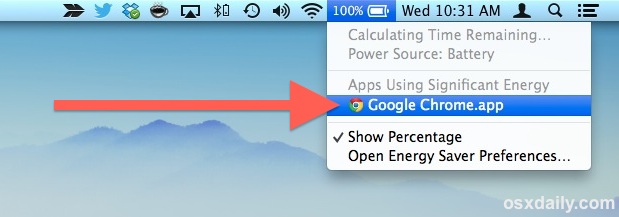
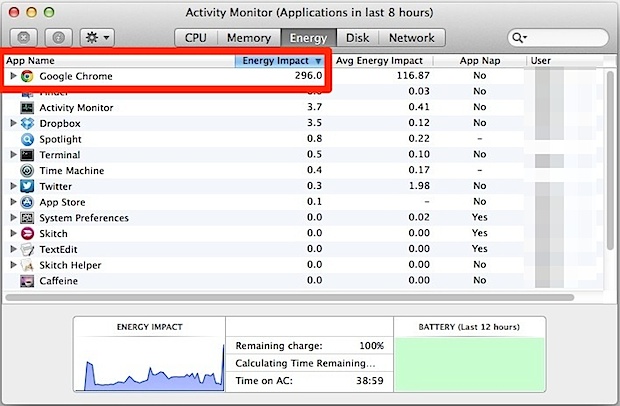
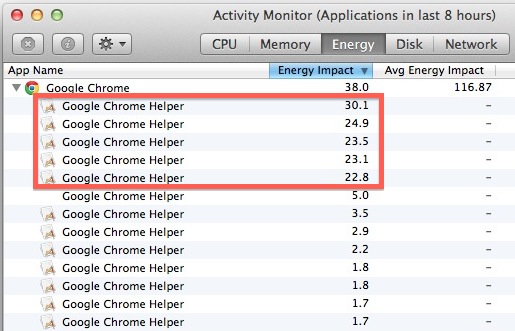
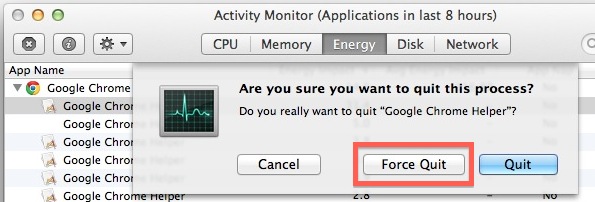
* If the menu says “Collecting power usage information” instead, just give it a minute to determine what’s hogging energy and it should quickly adjust to the energy indicator instead.
In a moment or two (you can adjust the reporting speed), the “Energy Impact” indicator will drop dramatically. You can repeat this as necessary if there are multiple processes eating a lot of energy (this typically usually means they’re using a lot of processor, memory/swap, or disk usage).
To continue with web browsers as an example, you likely just ‘killed’ a tab or window that had something like flash, video, java, or a variety of other plugins running within it. These type of things can run in the background and go unnoticed, particularly to those who regularly use tabs and multiple windows when going around on the web. This is demonstrated well in the screenshot below, where several of the active browser windows/tabs are using a lot of energy (all running YouTube in this case), vs the tabs/windows below which are just normal webpages and thereby using barely any energy:
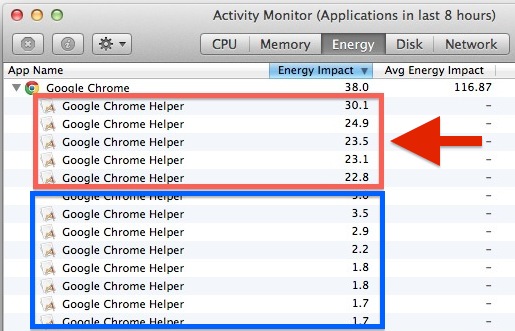
The App Nap feature within OS X is intended to mitigate those wild background processes, but in practice it doesn’t always work that well, particularly for browser tabs and windows, thus sometimes you’ll want to manually intervene as described above. It’s worth mentioning that the Chrome browser itself has a task manager built into it, but sometimes errant tabs/processes cause the entire browser app to misbehave and prevent access to that feature, while Activity Monitor almost always works.
The App Nap feature and the Energy Usage indicators are two of the better reasons for portable Mac users to upgrade to Mavericks of OS X, because it really can improve battery life quite a bit. Additionally, the OS X Mavericks is quite refined from 10.9.2 onward, so there is little reason to sit on the sidelines due to upgrade procrastination.
And yes, the Energy feature works on desktop Macs too, but since they don’t have battery life to worry about it’s typically a concern about performance rather than battery longevity.
Want to get even more out of your MacBook Pro or MacBook Air? Check out some more specific battery saving tips for Mac laptops.


Get the chrome extension “The Great Suspender”. It makes open (inactive) tabs dormant, so that they don’t use nearly as much processing power. Once you revisit the tab, it automatically reloads. There is also a whitelist available.
Force quit should be used last, as it is more likely to destabilize a parent process, or possibly the system.
Hitting the Quit button instead of the Force Quit, will gracefully shut down the process, including giving the user a chance to save work, if applicable. (Not sure if this covers posting replies; probably doesn’t, but in TextEdit, for example, it will invoke a Save dialogue.)
Summary: Make ‘Force Quit’ your last resort before rebooting.
If you hover over the exact process (Safari Web Content is the only one I’ve tested) it tells you which webpages are attached to it, and then you can control the pages without blindly force quitting.
Interesting that you chose Google Chrome for this example. I used to use Chrome a lot, but I got sick of it switching on my discrete graphics, which of course sucked my battery a lot faster. Even the most current version does this, and I was never able to figure out why.
This is only a concern on the 15″ MBPr and larger right? Does the 13″ have the same graphics?
No. The 13 inch system does not have discrete graphics. Therefore, this would not be a problem. My other issue with Chrome is that after over five years since its release for the Mac, it’s STILL a 32bit app. This means that it won’t work with 64bit Java 7, or any other plug-in that is 64bit.